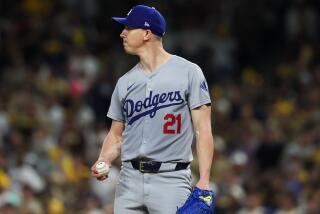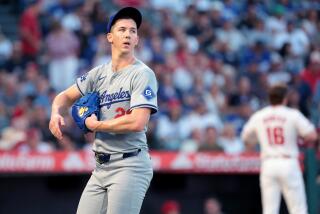Hanging On By His Fingertips : With Charlie Hough’s Career Seemingly Over, the Dodgers’ Tom Candiotti Is the Last of the Knuckleballers
Among the flamethrowers and the precision artists, there exists a pitcher of another kind, the oft-overlooked knuckleballer, whose success can sometimes be spoiled by something as trivial as a broken fingernail.
Tom Candiotti is the only knuckleball pitcher remaining in the major leagues, a legacy that extends to the few who came before him, but who will come after him?
“I’m a dinosaur,” Candiotti says.
Trips to Florida will not be the same for Candiotti, who would seek out Charlie Hough before games with the Marlins, two pitchers bonded by the knuckleball. On Wednesday, days after Hough announced glibly that he was rotting, he went on the disabled list because of a degenerated hip, and doctors are discussing hip replacement.
“Unfortunately, I wore out,” said Hough, 46. “Basically, there is no way I can pitch again.”
In the history of the game, there have been only 20 pitchers who have used the knuckleball for four years or more, a consoling statistic for catchers, most of whom would rather inhale sawdust than catch the pitch.
“I’d rather catch (Candiotti) than hit him,” Mike Piazza said. “It is funny, though, watching the hitters. They will guess and miss by a foot, and they cuss and yell and stuff.
“(Catching him) is just work, you can never relax back there, it’s just physically and mentally draining on every pitch.”
It is a difficult pitch to master, and one even more difficult to explain. Candiotti says he receives mail from all over the country from scientists and others who try to explain how a ball thrown with no rotation moves the way it does. Hough says he has never understood it.
“I’ve been throwing it for 25 years, and I don’t know how the hell it does that,” Hough says. “But what it means with only Tom left, is that it is really hard to throw.
“There will be another guy who comes along, though, somebody--Timmy Wakefield (of the Pittsburgh Pirates) if he gets it together. I don’t think we will be (extinct). Some kid will come along and not be able to make it and someone will say, try this. Usually we are pitchers who are not quite good enough and resort to that as our way of competing.”
The success of a knuckleball depends a lot on weather conditions--humidity helps the movement, thin air can flatten it. And its success depends on overcoming the embarrassment that sometimes can be associated with the wildness of the pitch.
“There are not a lot of people to teach it or that understand it,” said Candiotti, who has pitched more than 200 innings for all eight full seasons of his career, the longest current streak in baseball. “Tommy (Lasorda) does because there have been three knuckleball pitchers in this organization, Charlie, Hoyt Wilhelm and myself. But some catchers don’t want any part of it. You get passed balls and walks and guys steal bases.”
One of the most humorous questions asked Candiotti came in a postgame interview session recently, when a reporter asked what pitch he had working during a game. “Knuckleball, knuckleball and knuckleball,” Kevin Gross wryly interjected.
There are derivative pitches of Candiotti’s knuckleball--slow knuckleball and hard knuckleball--but it is not his only pitch.
“He has a good curveball, a fastball and a cutter,” said Carlos Hernandez, who catches Candiotti most of the time, which gives Piazza a rest. “He throws around 70%-30% knuckleballs to other pitches. But I love to catch him. You don’t know where his pitches are going, but sometimes I can see when he lets it go whether it will be a good knuckleball or a bad knuckleball.”
Even with the specialty of the skill, though, the irony is that a knuckleball pitcher, no matter how good, is not considered to be an ace. Aces, most say, throw smoke, not a ball that looks like a slow pitch in a softball game.
“When you watch a knuckleball pitcher and he loses, he tends to look bad,” Hough said, “but when a guy with a great arm loses, you say, ‘What a great arm, he lost, tough luck.’ ”
But Candiotti, if not the ace, has been a savior for the Dodgers this season, particularly on their recent 13-game trip, when he pitched four times in four cities. During that stretch, he gave up eight runs in 27 2/3 innings, for a 2.60 earned-run average.
“To have the courage to throw a knuckleball you have to have a lot of confidence in yourself,” said Fred Claire, Dodger executive vice president. “Rearing back and throwing the ball 90-plus, Tom can’t do that. But what Tom and Charlie Hough have in great similarity is that when the count is 3 and 2 they are not afraid to throw the knuckleball. It’s like staring at a 20-foot downhill putt and believing you are going to put it in.”
It was the final game of another bad Dodger trip this season when Candiotti demonstrated his competitive character. The team, which had suffered through three losses on the trip blown by the bullpen, needed a solid outing from Candiotti so the relievers could regroup. Candiotti, making his first start since the bullpen had blown a 9-4 lead for him in the seventh inning in an eventual 11-10 loss to the Marlins, pitched a five-hitter, beating the Chicago Cubs, 2-1.
“That game against the Marlins put the team in a downward spiral and it was difficult mentally,” said Candiotti, who is 7-6 this season with a 3.73 ERA. “But I think it’s a credit to anybody not to carry a grudge, and for us to be able to bounce back.
“I accept the role of being a supportive pitcher or an ace or whatever anybody wants to call me. But somebody sure thought I was pretty good to open the (1991) playoffs up in Toronto.”
*
Stuck on the 24th floor of a hotel recently and waiting for 20 minutes for an elevator was a group of Dodger players trying to get to the ballpark. Waiting outside the hotel was the team bus, which doesn’t wait for anybody.
The players thought about taking the stairs, but then would hear the elevator, which never stopped. Finally Candiotti searched around and found the service elevator. Wearing suits--it was getaway day--and carrying luggage, they piled in among the garbage cans, a situation in which Candiotti felt quite comfortable. “Those years in Toronto paid off,” he said.
During the second half of the 1991 season, Candiotti lived in the SkyDome Hotel above center field and used to go to work with the maids and the garbage men on the service elevator. He had been traded to the contending Blue Jays by the Cleveland Indians, for whom he had pitched seemingly unnoticed for 5 1/2 seasons. But the Dodgers had their eye on him, noticing that Candiotti’s 2.65 ERA at the end of 1991 was among the best in the American League. They went after Candiotti, a free agent, signing him to a four-year, $15.5-million contract at the age of 34. The Blue Jays offered only three years.
By signing with the Dodgers, though, Candiotti missed out on two championship rings. “It was OK, though,” said Candiotti, who lives in Los Angeles with his wife, Donna. “I was rooting for those guys. Before I signed with the Dodgers, in 1991, the Dodgers finished one game out from winning the division. There was no way of knowing what would happen.”
Victories have not come easily for Dodger starters the last couple of seasons, but Candiotti has seemingly suffered most. Last season he had the lowest run support in the majors--2.53 runs per game--and in 1992, he had the second-lowest run support in the league. But he finished both seasons with an ERA of 3.12 or less, last season finishing in the top 10 for the fourth time in eight seasons.
“It’s been tough the last couple of years, not getting a lot of runs to work with, but it made me a lot better pitcher last season,” Candiotti said. “It made me tougher mentally. I would say, two runs, that’s all I’ve got.
“I remember in Cleveland, I pitched 10 innings in a game and lost in the 10th by one run, 1-0 or 2-1. So when I was traded to Toronto, I thought that it would be great with their offense and all. But it started happening and I remember Manager Cito (Gaston) saying, ‘Oh no, Candi, not again.’ ”
Candiotti learned the knuckleball from his father, Caesar, in front of their house in Concord, Calif. After Candiotti graduated from St. Mary’s College in 1979, there was little interest from major league baseball, so he signed with an independent team in Victoria, British Columbia. He bounced around in the Kansas City and Milwaukee organizations, before Cleveland signed him to a triple-A contract in 1985. But Candiotti had thrown out his arm, and had reconstructive surgery after the 1982 season. After that, he started using the knuckleball.
“He’s been a staff saver for us,” Dodger pitching coach Ron Perranoski said. “He has filled in on two days’ rest, three days’ rest and he has been sharper and sharper the last five or six starts.”
Candiotti says he wants to keep pitching as long as he can. “Phil Niekro was 48 or 49 and Wilhelm was 49 and Charlie is 46,” said Candiotti, who is 36. “In the history of baseball, I am only the 20th pitcher that’s used the pitch for four years or more.”
Said Hough: “I didn’t know there were that many.”
More to Read
Are you a true-blue fan?
Get our Dodgers Dugout newsletter for insights, news and much more.
You may occasionally receive promotional content from the Los Angeles Times.









